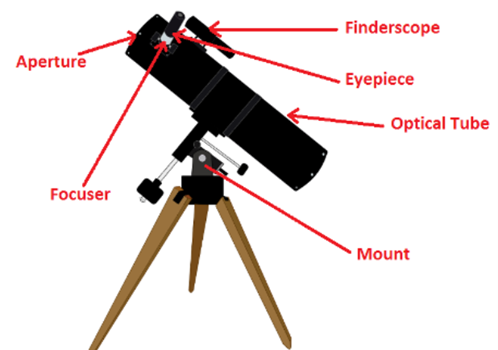Table of Contents
Modern telescopes, whether on Earth or in space, help us explore the universe by collecting and focusing light from distant stars and galaxies. They act like a window into the cosmos, allowing astronomers to uncover its wonders and reminding us of the joy of discovery and our place in the universe.
About Telescopes
- It is an instrument that uses lenses and mirrors to collect and focus light to observe distant objects in space.
- They use lenses or mirrors to bend light rays and make distant objects appear close.
- They are an essential tool for astronomers to study the universe by collecting and analysing radiation from celestial objects.

- Aperture:
- Itrefers to the opening that collects light.
- A larger aperture allows more light to be gathered, creating clearer and more detailed images.
Types of Telescopes
- Refracting Telescope:
- Uses lenses to gather and focus light.
- The first telescopes, invented by Hans Lippershey and improved by Galileo, were refractors.
- These are known for sharp images but can suffer from chromatic aberration (color distortion).
- Reflecting Telescope:
- Uses mirrors instead of lenses to collect light.
- Invented by Isaac Newton to overcome the issues of chromatic aberration.
- Most large telescopes used in observatories today are reflectors.
- Catadioptric Telescope:
- Combines lenses and mirrors to form the image.
- These telescopes aim to reduce the limitations of both refractors and reflectors, offering a more compact design.
How Telescopes Work?
- Light Collection: Telescopes collect light from distant objects using either a lens (refracting telescope) or a mirror (reflecting telescope).
- Magnification: The light is then magnified using eyepieces, allowing the observer to see faraway objects in greater detail.
- Resolution: A telescope’s ability to resolve fine detail depends on its aperture (the diameter of its primary lens or mirror). Larger apertures collect more light and provide clearer, more detailed images.
| Famous Telescopes |
|
Why Telescopes are set up on Mountains?
- Mountain observatories provide clearer skies due to reduced atmospheric distortion.
- Space telescopes, above the atmosphere, deliver even clearer views.
- g. Hubble Telescope
| Advanced Telescopes around the World |
|


 Perovskite Solar Cells, Objective and Ch...
Perovskite Solar Cells, Objective and Ch...
 Navy-Marine Expeditionary Ship Interdict...
Navy-Marine Expeditionary Ship Interdict...
 K2-18b Exoplanet: Potential Biosignature...
K2-18b Exoplanet: Potential Biosignature...






















